A Giant Sculpture - for health?
- artsandhealthgipps
- Apr 7, 2019
- 2 min read
Updated: Aug 10, 2019

For the last two years, twenty or so women have been working on creating a giant model of a human placenta. Why would they do such a thing?
The placenta is the essential organ created during pregnancy, and with a healthy birth, is discarded in the hazardous waste of the hospital. In a very small percentage of hospital births, the birthing parents take the placenta home to bury it with a newly planted tree. Interestingly, there is some new Australian research (at the Hudson Institute of Medical Research) that has identified a therapeutic use for placental cells in the lungs of prematurely born babies.
Essentially, though, our Australian culture has a tradition of discarding the placenta as waste, even though the creation of the organ has cost the birthing parent a huge physical resource in the first months of pregnancy, where the only outward sign of this investment is appalling nausea.
Our Australia culture is quick to define things as waste. While we are generally good at recycling, often our 'recycling' is in fact shipping it overseas for other nations' industries to make use of.
Our developed-world culture is also very quick to apply the principles of profitability to human effort, often to the cost of the humans involved in that effort. Domestic labour - housework, child nurture, community cohesiveness - these efforts are often completed by women, and this effort is often discounted in the eager representation of the economic profitability of the state. When calculating the Gross Domestic Product, what women do has been, and is still largely left out, and yet it represents an overwhelming contribution to societal wealth and wellbeing (additionally, it is being recognised in the economies of the developing-world).
For example, women in the later years of their careers will often take time off, or leave work altogether, to care for their ageing parents; or they may have to leave work permanently to care for a disabled child. Women's care for their community is often unseen. Any organisation that utilises a volunteer workforce knows how the proportion of women to men is vastly unequal, with women contributing the major percentage. Many community health groups benefit from volunteers who increase the reach of their paid workforce exponentially.
But - back to the giant model of a placenta - what does this have to do with health, or #womenswork ? The sculpture is made from over 800 discarded cotton t-shirts. The shirts are thoroughly washed of their grime, cut and re-sewn into tubes, then dyed, then cut again into continuous yarn. Then using the centuries-old 'craft' (technical skill), the yarn is knitted into giant sections of soft, vibrant, fabric.

The soft sculpture is a symbol of work done by women; to nurture, to feed, and to sustain. For a few short moments of contemplation, the viewers of this huge monument may feel gratitude for the unseen work of women that was essential to their unborn development, and which - in ongoing ways - contributes to their health and wellbeing.







































Comments